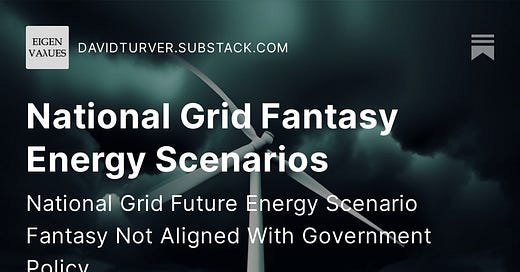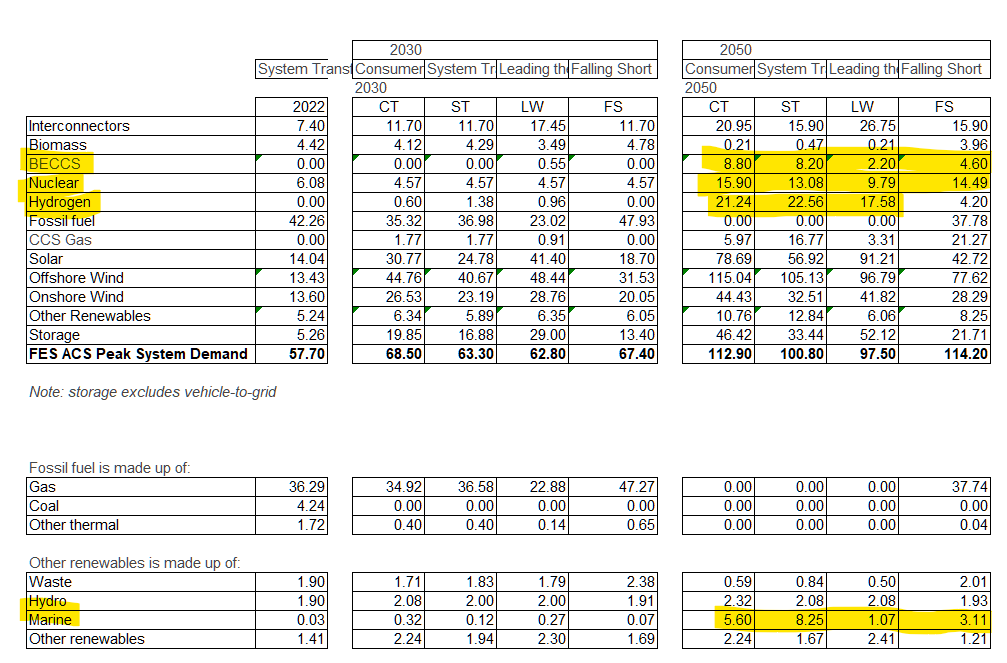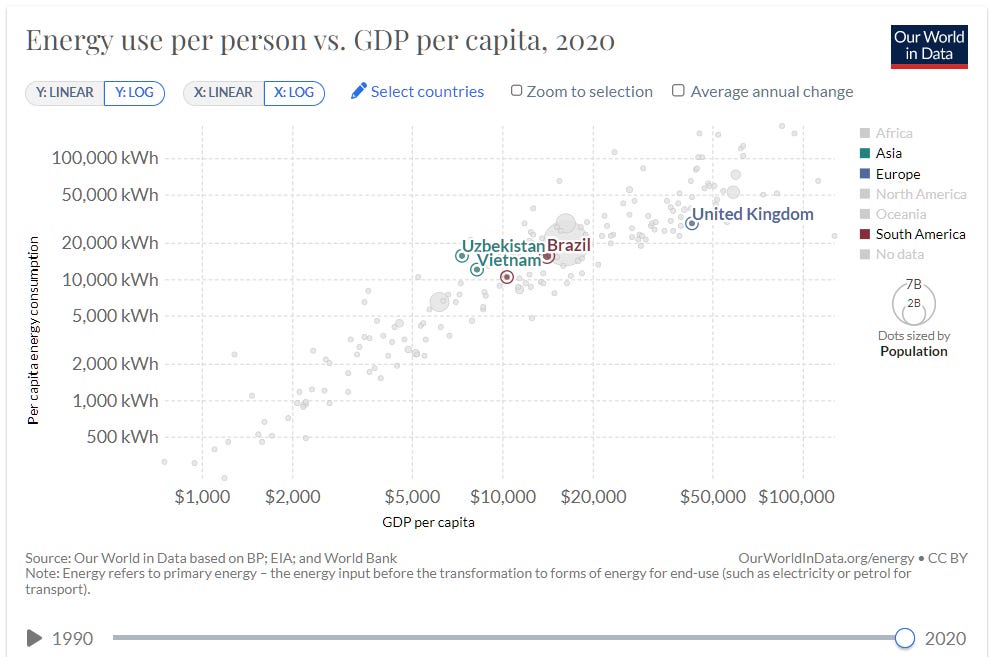National Grid Fantasy Energy Scenarios
National Grid Future Energy Scenario Fantasy Not Aligned With Government Policy
Introduction
Earlier this week, National Grid ESO launched their 2023 edition of Future Energy Scenarios (FES). By coincidence the Department of Energy Security and Net Zero (DESNZ) made a preannouncement of their plans for nuclear power.
This article explores the worrying differences between the Government and the people who actually run our grid and a first glance at some of the fantasies embedded in the FES report.
National Grid and UK Government Not Aligned
Perhaps the most worrying thing is that the DESNZ and National Grid ESO are not aligned. Energy Live reported that the Government is about to announce a commitment to 24GW of nuclear capacity to be delivered by 2050. They say that would represent a quarter of our generating capacity. That would make our total generating capacity at 96GW. It seems likely that Energy Live were mistaken when they said nuclear represent a quarter of generating capacity. More likely they meant a quarter of electricity generated.
However, National Grid ESO (Table ES10 in the data workbook) put nuclear at between in the range 9.8-15.9GW by 2050 as shown in Figure 1 below. That is a noticeably big discrepancy. Do the Government talk to National Grid? Do they actually communicate?
National Grid ESO justify this by saying “with high levels of renewable capacity, significant levels of baseload generation can be challenging as they contribute to curtailment issues at times of low demand and high renewable output.” In other words, they have decided that dependable, always on nuclear power is a bit of an inconvenience when their precious renewables are sometimes producing more than we need. Of course, those pesky nukes will also be producing power on those dark, cold, windless nights in the winter, when the power is most needed.
National Grid Fantasy Energy Scenarios (FES)
Their stubborn insistence on a wind and solar heavy grid leads to some quite astonishing gymnastics elsewhere in the report.
Astonishing Cuts in Overall Energy Use
First, is the massive overall cut in energy demand across Residential, Industrial & Commercial and Transport sectors as shown in Figure 2 (taken from the FES 2023 Energy Flow Diagram tab).
They are proposing that we get by with 35-52% less energy in 2050 than we used in 2022 in their scenarios that achieve Net Zero. Of course, you are not going to need reliable baseload power as much if you cut overall energy use. As I have said before, there are no rich countries with low energy use as shown in Figure 3, taken from Our World in Data.
Why is there no discussion about the risks of planning for energy scarcity?
BECCS Crime Against Thermodynamics
Second, as shown in Figure 1, they include up to 8.8GW of BECCS generation. BECCS is bio-energy with carbon capture and storage. This means burning trees and capturing the CO2 emitted and then pretending the overall process actually takes CO2 out of the atmosphere because eventually the trees grow back. However, as I previously highlighted, the Royal Society of Chemistry (see Figure 4) has calculated that BECCS using wood pellets from Louisiana has an Energy Return on Energy Invested (EROEI) of less than 1. This makes it a net energy sink. Why would the National Grid be promoting such a thermodynamically illiterate solution to our energy needs?
More Spending on Intermittent Wind and Solar
As can be seen in Figure 1, they are proposing 4-6.5 times more solar capacity, a 7-8.6 times increase in offshore wind and 2.4-3.3 times more onshore wind than we had in 2022. As previously discussed, these technologies are not very sustainable. They score well on CO2 emissions, but very badly on other metrics such as land use and mineral usage. In addition, they have extremely low energy return on energy invested (EROEI), particularly when buffered with storage to try and overcome the fundamental problem of intermittency. Good luck with installing that extra capacity, and the required replacements when the industry is already saying costs are rising and they need even more subsidies.
They are trying to overcome the intermittency problem with “Demand Side Response” (DSR) (which is just a fancy phrase for energy rationing) and hydrogen. We end up paying for the DSR through our bills and hydrogen has its own problems.
Hydrogen Bubble
National Grid ESO is still obsessed with hydrogen to produce electricity. They see massive electrolysis plants producing hydrogen from excess wind and solar power on sunny and windy days. This approach is problematic for several reasons. First, they admit that the “round-trip efficiency” of making, transporting, storing and then burning the hydrogen to produce electricity is low. However, they believe it is worth it, because the electricity produced by renewables at times of low demand would otherwise be worthless. This seems rather a circular argument to justify installing so much wind and solar capacity.
They admit they will need lots of storage to make this solution work. In fact, they say they will need 12-56TWh of storage capacity. The trouble with this approach is they admit that “investor uncertainty remains high,” that most of the hydrogen storage projects are currently only in the “scoping phase” and post-2030 hydrogen storage will depend on “future revenue streams and the support available.” In other words, hydrogen is going to need lots of subsidies to get as yet unproven technology to market, yet they are relying on it to mitigate the intermittency of renewables.
DACCS Energy Sink
Direct Air Carbon Capture and Storage (DACCS) also figures in their plans. This is literally sucking carbon dioxide out of the air and storing it underground, potentially in depleted offshore oil and gas fields. They say “DACCS could play a key role in the management of network constraints and reducing balancing costs if it is in the right location.” In other words, they need to find another use for the excess wind power generated on windy days, so they might as well sink it into DACCS. They admit that there is “uncertainty over the readiness for commercial use” and there are “questions about [DACCS technologies] to operate at scale.” Norway has recently closed its CCUS plant because of high costs.
Dunkelflaute Delusion
Their analysis of dull windless periods, called Dunkelflaute in Germany, also leaves a lot to be desired. They chose the “extreme weather” in the period 19 February to 3 March 1985 as their baseline for how the grid would operate in 2050 as seen in Figure 5.
There are problems with their analysis. They assume that all of their storage is full at the start of the wind lull, falling to zero just before some miraculous gusts of wind appear so renewable generation can replenish the storage before the wind drops again. The plan relied upon imports of Norwegian hydro-power because the rest of Europe was also in a more strained situation. They also assume that they ration demand using DSR.
Conclusions
In essence, they are basing the Future Energy Scenarios around an energy scarce world with low EROEI and in many cases intermittent and sometimes unproven technologies. The mitigation for intermittency is both expensive and unproven. What could possibly go wrong?
My own belief is that we should be basing our future grid largely around abundant nuclear power, and work to address the apparent cost and time disadvantages.
[Update 13 July 2023] Paul Homewood has also done an excellent piece pointing out additional weaknesses in the FES that can be found here. [/Update]
Acknowledgement: The inspiration for this article came from this excellent Twitter thread by Richard Ollington, although we have covered slightly different aspects of the 2023 FES Report.
If you have enjoyed this article, please share it with your friends, family and colleagues and sign up to receive more articles like this.









Excellent analysis. As you say, National Grid seem to be living in fantasy land and this is bound to end in disaster.
Paul Homewood of the NotALotOfPeopleKnowThat blog has already posted on the madness of National Grid’s FES 2023, see https://notalotofpeopleknowthat.wordpress.com/2023/07/10/fes-2023-the-emperor-still-has-no-clothes/.
I mention Paul’s post because I have just noticed an awakening in some of his commenters. For many years most of them (and myself until recently) have taken the view that our politicians are “technically challenged” and can be educated to see sense. In this post, several of them have realised that this approach is futile because the looming Net Zero energy infrastructure disaster is deliberate policy. For example see https://notalotofpeopleknowthat.wordpress.com/2023/07/10/fes-2023-the-emperor-still-has-no-clothes/#comment-254876 and the two comments above it.
The best way to debunk Net Zero is to expose it as deliberate policy to deindustrialise and depopulate the Western world. Our politicians are acting as puppets to their globalist overlords and paymasters. In the words of the Club of Rome “The real enemy, then, is humanity itself”.
This paper seems to endorse my daily Telegraph paper that points out that before any country gets into a large scale wind and solar power it needs to have a storage technology that is large-scale and low cost. No such technology appears to exist at the moment. Until it does, wind and solar power are pointless.
http://www.bryanleyland.co.nz/newspaper-articles.html "Cheap storage" (amended for New Zealand